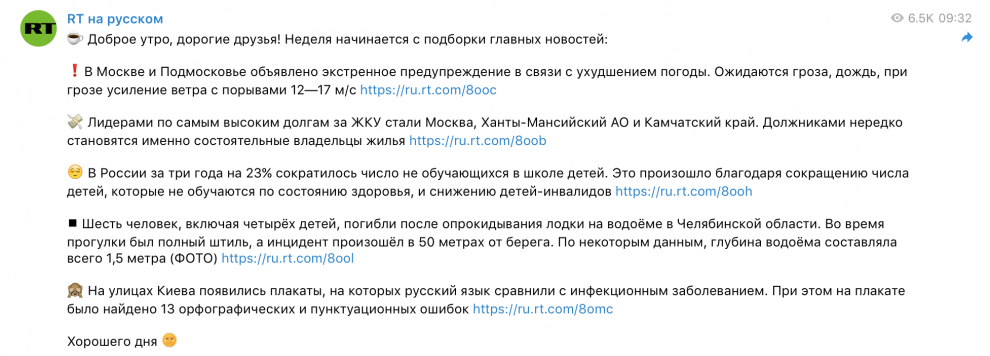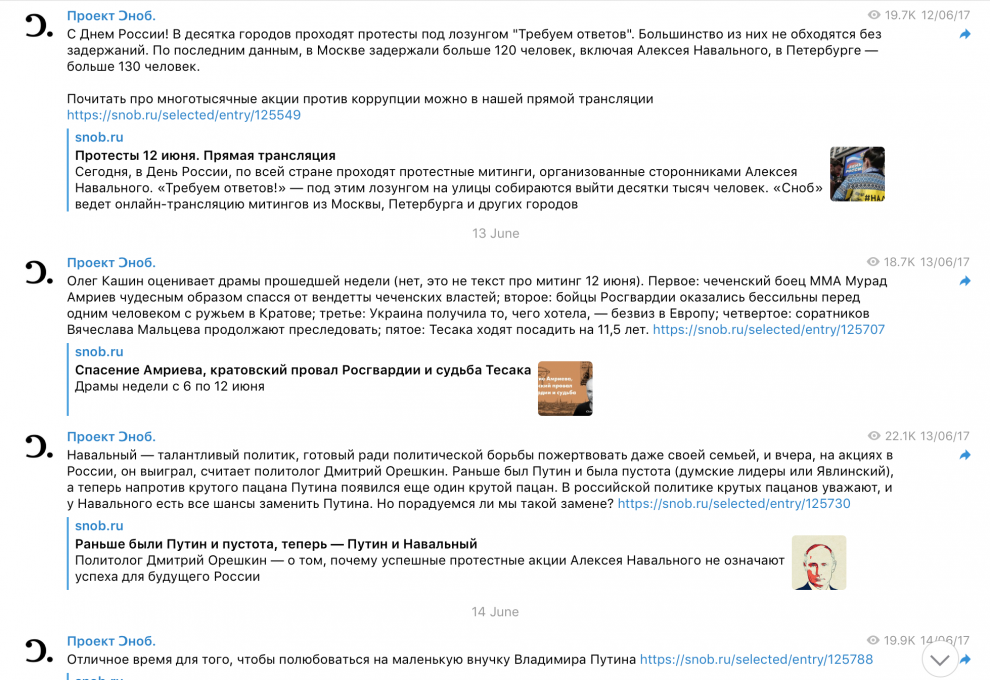
Telegram is far from the most popular messaging app in Russia, but it’s been the one under fire recently.
At the end of June, the app faced pressure from Russia’s communications regulator Roskomnadzor to register information about Telegram on an official government list and seemed on the verge of being blocked entirely. Russia’s FSB security service also announced that terrorists who’d carried out the April St. Petersburg metro bombing had used Telegram to communicate. The threat of blocking resulted in a sudden increase of the downloads of the app, followed by an equally quick resolution after Telegram agreed to formally register in Russia.
The incident is notable because Telegram’s most heavily touted features have been the security and privacy afforded to users. The app’s biggest user base is in countries like Iran, Malaysia, and Uzbekistan, where access to the Internet is restricted. In Russia, Telegram follows WhatsApp, Viber, and Skype as the fourth most-used messaging app.
Unlike WhatsApp, Telegram offers the option of unlimited subscriptions to public channels, which helps explain why many media and individual pages have flourished there. One attempt to sample the demographics of the user base on Telegram surveyed 3,612 users and revealed a common portrait of men between the ages of 25 and 30 who work in the digital sphere and mostly live in Moscow. (The survey is self-selecting, but at least one outlet, Snob, seemed to be reaching a similar demographic, according to editor-in-chief of the website Egor Mostovshikov.)
I spoke (in Russian) with editors of some of the most popular media channels on Telegram to learn what features the most successful ones share and how the audience on Telegram in particular is different from the audiences on other popular social and messaging platforms.
Alexey Ponomarev, distribution editor:

Our main channel is an editorial public channel called Meduza Live. The key idea there is to tell why a certain piece is interesting to a certain journalist. That is why all the posts there are signed — for example, the investigations editor would write why he likes a new investigation of someone from his team, and then post it to the Meduza Live Telegram channel. We suppose that readers like to get a personal message, from a journalist they know. In the year that I’ve run the channel, it has grown from 10,000 to 36,000 followers and still grows, albeit not as fast.
Besides the Live channel, we have a few auxiliary channels. For instance, Meduza Evening has all the content of our evening newsletter for the audience that does not want to read emails. It’s a younger audience there, around 20 to 25 years old, and they feel like using email in 2017 to get news is too much. There is also a separate channel for all the Meduza news, and another one only for breaking news, and funny stuff on yet another channel — but all those except the Meduza Live are automated and created for audiences’ comfort.We just try to be present on various platforms in the way people would like to consume news, and we keep to an informal language, avoiding news cliches and bureaucratic jargon. In Telegram, the communication between a reader and the newsroom feels almost like a personal conversation, since we get immediate feedback through a separate dedicated channel that we created just for messages from the readers.
Editor’s note: RT, formerly known as Russia Today, is controversial, often considered a mouthpiece for Russian president Vladimir Putin and the Kremlin. We thought it was valuable nevertheless to get some insight into how they approach their audiences on new platforms.
Anna Belkina, director of marketing and strategic development:

For Telegram, we send the best of our stories and compile two digests per day with the most interesting RT content in our view, published when people are getting to work in the morning or when they are back home in the evening. On weekends, we publish the morning digests earlier and the evening ones later, so as not to disturb people during their weekend activities. With that concern in mind, we will often keep silent for several hours if nothing interesting happens, but at the same time, we will publish several stories in a row when there is breaking news, and the subscribers will not take it as intrusiveness.
We send the stories to Telegram as we would send stories to a friend, giving an explanation or a funny comment. One of our notable efforts was to start publications with emojis, and we’ve noticed that others have started doing this as well. On the other hand, it’s important to stay polite while being informal. We tried rap digests and rhymed digests — these posts feel fresh, and the reader understands that the channel is managed by a real person, usually someone from our social media team, which consists of three people.
Egor Mostovshikov, website editor-in-chief:

Our Telegram channel launch was an initiative of one of our news reporters, who also has a side channel in Telegram about media. Our channel was opened in May 2016, and had around 150 users without any strategic promotion. In July 2016, we started working on development more consciously, and had 3,000 people signed up by September. For a few months it was growing fast; now it is still growing, though not this fast anymore. The audience is at around 20,000 subscribers, ranking third among the media channels in Russia. We don’t get any audience feedback, but we know that the majority of them are men 25 to 34 years old, usually from Moscow, using phones, since we get the information on referrals from Yandex.metrics.
We publish the announcements of news and stories, just as we do on the other social media. However, we do not duplicate the text from our other social media channels in our Telegram channel. On Telegram, there is a sense that the subscriber will actually read the message, not just scroll away from it. It has way less distraction than social media, hence you don’t fight for the attention. Specific tips to managing a Telegram channel is keeping things short — you might want to skip the greeting to save space, not send too many messages per day, and establish trustful communication. It is important also not to send the message too late, otherwise you irritate your readers, although some channels I have seen do that, and their audiences are still loyal to the hour. It is still a new platform and a place for experiments. It is also important to promote it on your website and other pages.
Vladimir Motorin, website editor-in-chief:
It’s important to understand that Telegram is a platform with hundreds of thousands of active users in Russia, with some of the biggest public channels enjoying an audience of 50,000 to 60,000 users. Hence, we develop ours, but we also don’t spend too much time, money, and resources to find a special way to talk to this audience.

On the other hand, messengers are big competitors to social media as places where people consume news, and Telegram is showing good results. Our audience has grown from 9,000 subscribers three months ago to 14,000 subscribers now. We have promoted Telegram through our main TV Rain website. Plus the audience of the messenger app as a whole is growing, too. We have had some successful posts that went viral, such as the news about postponing the “Direct Line” with Vladimir Putin — which gave us the biggest number of referrals to the main website, about 4,700. As for other successful posts, they could result in 1,000 to 2,000 referrals to our website. It doesn’t seem like a lot, when compared with our other distribution channels such as our Facebook page. On the other hand, 2,000 referrals does mean that one out of every seven Telegram subscribers have actually gone and read the full story on our site.
Natalia Touzovskaya, BBC Russian social media editor:

We are currently working in the format of the evening daily news distribution list. Our social media producer puts it together and then our social media editor checks it before publication. We take into account several factors: the evening peak of our audience, the day’s editorial agenda that reaches maximum clarity by evening, our editorial priorities regarding the news. We want to tell our audience about major political news as well as technology, arts, science, and “softer” stories.
Having said that, we realize that the majority of referrals to our website from Telegram are delivered by hard, political news stories. Obviously, a timely delivered major news story gets a higher viewing and delivers more references. But we don’t want to turn our channel into a “breaking news” distribution list.
Taking into consideration our ambition to expand our young and female audience, we don’t prioritize just political news but continue to offer our readers a variety of stories.
Interviews were originally conducted in Russian.